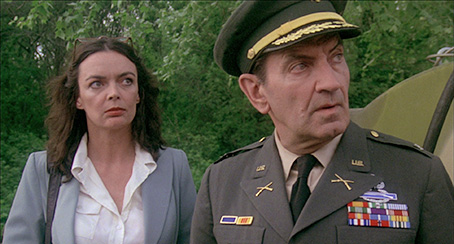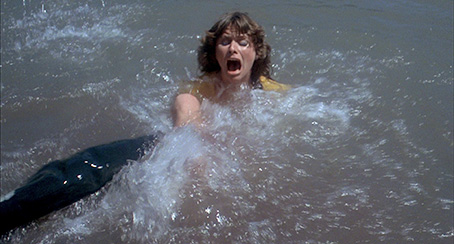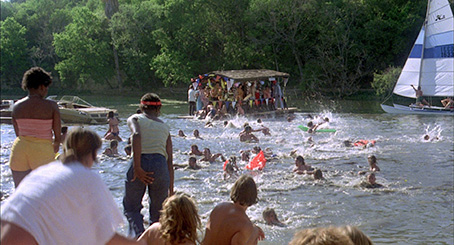"But the piranhas..." |
"What about the goddamned piranhas?" |
"They're eating the guests, sir." |
I was still at film school when Piranha first hit UK cinemas. Back then I had easy access to a lot of cinema screens and went to see just about everything that was showing, but I'd have gone to see a film called Piranha anyway. To sweeten the deal, the cinema (or more likely the distributor) had teamed it with a re-run of Brian De Palma's Carrie, which by then was already on the road to establishing itself as the horror classic that it has since become, a double-bill that effectively cast this low-budget young upstart as the supporting feature. For us keen young film fans those really were the days, two feature films for less than the price you'd probably pay for a bucket of popcorn today. Mind you, with home video systems then still a couple of years away, they needed to be, as this was our only access to movies that weren't being shown by the three TV channels we had at out disposal. Bloody hell, writing that last bit makes me feel old.
I'd known little about Piranha before seeing it, apart from a couple of cautiously positive reviews I'd read in film magazines, but I really, really liked it. It was smart, witty and in places rather violent, an energetic, low-budget horror film run through with a vein of knowing comedy and a touch of eco-politics. Ed, my unfeasibly tall viewing companion also really liked it. As it turns out, we were the only ones who did. Fired by our enthusiasm and the prospect of revisiting Carrie, most of our classmates scurried off to the cinema in our wake, and while they all enthused wildly about the main feature, they hated Piranha with a venom that bordered on the ridiculous. For them, it was a cheap, idiotic and laughable excuse for a film, and Ed and I were repeatedly ridiculed for liking it (the fact that Ed was the only other person on the course with as keen an enthusiasm for cinema as me is something I'll let slide). The fact that it was also borrowing liberally from Jaws – another supremely well made genre classic – only made matters worse. Our suggestion that it was simultaneously trading on that film's iconography and sending it up fell on determinedly deaf ears.

In retrospect, the teaming of two such stylistically different genre works was asking for trouble, particularly when the main feature already had a such a following. The audience went to see Carrie and expected the supporting feature to be its stylistic blood brother, which Piranha was not.* There was none of Carrie's technical swish and Freudian grand guignol here; Piranha was made on the cheap for Roger Corman's New World company by enthusiastic young filmmakers looking for their big break. The mix of horror, sly comedy and politics, at least as it played out here, was relatively new, and my classmates seemed unwilling to take that on board.
That, it turns out, was set to change. Little did we know at the time, but Piranha was set to spearhead a new breed of horror film whose popularity peaked in the early 1980s, one that rethought and reinvigorated the traditional monster movie, infusing it with energy, new ideas, smart and witty dialogue, and the sort of post-modernist referencing that was soon to become the American horror movie's stock-in-trade. Two key figures in this development of the genre were producer Roger Corman, who'd been doing this sort of thing himself for years and had a real eye for future talent, and screenwriter John Sayles, who co-wrote Piranha, Alligator and The Howling, three of the shining lights of this emerging sub-genre (the most widely celebrated example of which was John Landis' excellent An American Werewolf in London),** and as we all know went on to become one of America's most respected independent filmmakers. Indeed, Piranha proved to be a career launcher for a number of later film notables: it was John Sayles' first screenplay; the first solo feature for director Joe Dante (later to have hits with The Howling, Gremlins, Explorers and Innerspace); the first editing job for later Oscar nominee Mark Goldblatt (The Terminator, Terminator 2: Judgement Day, Starship Troopers); and the first special makeup credit for a then 17-year-old Rob Bottin (The Howling, The Thing, Se7en, Fight Club). It also gave future effects man and director Chris Walas (who did the effects on The Fly, Arachnophobia and Naked Lunch and directed The Fly II) his first credited film job and was an early film for celebrated effects man Phil Tippet (Star Wars, Dragonslayer, Robocop and Evolution). Quite a graduation class.
The tongue-in-cheek aping of Spielberg's big fish movie is evident from the start, as a young backpacking couple break into what appears to a long abandoned industrial plant and take a swim in its Olympic sized pool, only to be attacked and pulled under by who knows what. Well, given the title, we've got a pretty good idea. Enter spunky skip tracer Maggie McKeown, who has been hired to track down the missing kids and bullies heavy drinking divorcee Paul Grogan into helping her out. His local knowledge helps her locate the spot where the couple met their fate, which turns out to have once been an army testing base. After finding signs that the couple have been there, they drain the pool to search for their remains, which prompts wild-eyed scientist Dr. Robert Hoak to pop out of the woodwork and unsuccessfully attempt to stop them. They soon discover why. The pool was filled with genetically modified, weapons-grade piranha, which have now been let loose into the local river and are heading downstream towards the very summer camp at which Paul's young daughter Suzie is staying.

That Corman, Sayles and Dante are ripping off Jaws is never in question and is cheerfully announced in a post-title sequence in which Maggie is unable to focus on the task at hand because she's so wrapped up in playing a Jaws video game. There are thus no apologies for reworking some of the earlier film's scenes and visual tricks, with the underwater POV fish shots and the climactic attack on the tourist resort lifted almost wholesale. But right from the start there's an energy, wit and political subtext here that collectively distinguish this film from its big budget predecessor. The main characters may lack depth but are economically defined and most engagingly played, with Heather Menzies' bossy determination as Maggie nicely counterpointed by Bradford Dillman's grumpy reluctance as Paul. Dante also scores some neat cult casting in the supporting roles, with Barbara Steele as government scientist Dr. Mengers, Death Race 2000 and Eating Raoul director Paul Bartel as summer camp leader Dumont, and Corman and Dante favourite Dick Miller as resort manager Buck Gardner. The piranha themselves prove to be the result of a military programme to breed a strain of killer fish for use as a weapon in the Vietnam war ("There'll be other wars" Paul is told when he points out that the conflict is over), and this must be the only creature feature in which polluting a river is proposed as a solution to the problem instead of its cause.
As a briskly paced and entertaining exploitation horror, the film holds up remarkably well. Most surprising of all is the effectiveness of the piranha attacks, a vicious and bloody blizzard of accelerated puppetry, blink-of-an-eye editing, convincing prosthetics and frantic mechanical whirring that never comes over as cheap or comical, and at its best is easily as nasty as anything subsequent CG monsters have managed to suggest.

That the film works so well seems retrospectively less surprising when you consider the pool of talent behind it, enthusiastic newcomers and film school graduates who all leapt at the opportunity to work for Corman. Technically solid and enthusiastically performed without a trace of camp or hesitant amateurism, it's way more fun and a hell of a lot smarter than any of Corman's own increasingly preposterous follow-up films (the first of which, Piranha 2: The Spawning, was inauspiciously directed by a young James Cameron). Everyone involved here acquits themselves well (with one small exception – check the commentary track below), but watching it again after so long a gap it's John Sayles' screenplay that delights the most, for the economy of its storytelling and character creation, for its structural neatness and inventive twists, and most of all for its unforced wit. A favourite example comes when an irritable Paul is being held with Maggie in an army tent under the guard of a single sentry, and we are treated to the following priceless exchange:
Paul: |
"Is he still out there?" |
Maggie: |
"Yup." |
Paul: |
"Then you'll have to distract him." |
Maggie: |
"Why?" |
Paul: |
"So I can get away." |
Maggie: |
"So YOU can get away? What about me?" |
Paul: |
"All right, suit yourself, but first you're going to have to distract him." |
Maggie: |
"How?" |
Paul: |
"Well how would I know? Just get him with his back to the opening there. You know, come on to him." |
Maggie: |
"What if he's gay?" |
Paul: |
"Then I'LL distract him!" |
It seems only fitting that the soldier in question is played by Sayles himself.
As so often with low-budget 70s exploitation films, my expectations for this new Blu-ray transfer weren't all that high, and the imperfect black levels, slight contrast flicker and earthy colours of some the opening shots of the young couple making their way into the abandoned military base at night did little to convince me I was wrong. But once daytime arrives the image quality improves, and when Maggie rolls up in her hired Jeep bathed in sunlight, the contrast, colour and level of detail are really impressive. OK, the image never displays the sort of eye-popping sharpness that you'll find on a modern mainstream Hollywood release, and the level of grain can vary from shot to shot (the result of enlarging some shots in editing to exclude unwanted elements), but this is easily as good as the film has ever looked on home video and is a major cut above the previous DVD release. A few dust spots remain, but for the most part the picture is clean and free of damage.

The dynamic range of the Linear PCM 48 stereo soundtrack is a little narrower than you'll find on a more modern mainstream movie, but is otherwise in good shape, with all of the dialogue clear (despite the problems Dante had with his sound man) and the music and sound effects cleanly and effectively rendered. There is very little in the way of stereo separation, but this is not major issue.
Commentary by director Joe Dante and producer Jon Davidson
Although ported over from an earlier DVD or laserdisc release (a late comment by Dante suggests it was recorded in 1999), this a hugely enjoyable track and it's reproduction here is warmly welcomed. Dante does the lion's share of the talking and has plenty of entertaining stories to tell about the production, the cast and crew, and the creation of its effects. He's also distanced enough from the film's initial release to not be overly precious about it, despite how well it eventually turned out – at one point he was convinced that he had made the most terrible movie ever and John Sayles was apparently so appalled by the rough cut that he considered getting straight back out of the business. It's here that I learned that renowned composer Jerry Goldsmith's son Joel was the film's location sound recordist, a job that apparently just wasn't his forte and took a turn for the worse when he fell in the water with all his equipment. There are plenty of other engaging and often informative anecdotes, but my favourite has to be Corman's stated reason for keeping the end credits short: "If it takes that many people to make a picture like this we look silly."
Behind the Scenes (9:35)
An interesting collection of silent 8mm movies shot on set by producer Jon Davidson, who together with Joe Dante provides a commentary on the action, which mainly involves pointing out who is who and clarifying what we are watching. That said, there is a brief but entertaining story about how there pair were confronted by an angry home-owner with a shotgun when scouting for locations in Texas without a permit. "How stupid were we?" wonders Dante cheerfully. The picture quality is very good and there's hardly a dust spot to be seen.
The Making of Piranha (19:46)
A busy, revealing and entertaining retrospective documentary in standard definition that I'm guessing was made a few years ago for a previous DVD release. Built around interviews with many key members of the cast and crew – including Roger Corman, Joe Dante, effects men Peter Kuran, Robert Short, Chris Wallas and Phil Tippett, and actors Melody Scott, Belinda Balaski and Dick Miller – the main focus is the creation of film's visual and mechanical effects, which are explained in fascinating detail and peppered with amusing anecdotes, including how Chris Walas overcame his fear of water and what Belinda Balaski went through to get star billing.
Outtakes (6:40)
An engaging enough collection of fluffed lines, uncooperative props and general goofing around. Includes one shot that's not in the theatrical cut of the film but made it into the TV version, where extra footage was needed to replace all the stuff the network wanted removed.
Stills Gallery (2:01)
A silent rolling gallery of production stills and a couple of posters, all presented full screen (well, vertically, anyway – pleasingly, they've not been cropped to fit the 16:9 frame) and in high definition. It's rare to see a stills gallery of this quality.
Radio Spots (1:37)
Three radio ads for the film narrated by the Voice of Doom that sell the film as a deadly serious horror. "Their razor teeth can strip a man to the bone in seconds. And now they're here, in the lakes and rivers of America!"
TV Spot (0:32)
A brief TV trailer for the film that although takes a similarly serious line to the radio spots, does include the "they're eating the guests" exchange, though it's not clear whether we're being asked to see this as humorous or camp.
An old favourite that not only stands up really well over 30 years after its original release, but is smarter, more fun, and has more engaging characters than the majority of American horror movies doing the rounds today. Second Sight's Blu-ray is a must for fans of this short-lived but fondly remembered strand of witty US horror, boasting a better than expected transfer and some excellent extra features. Warmly recommended.
* That both films were scored by respected Italian composer Pino Donnagio is, we can assume, purely coincidental.
** It's worth noting that the passing of time and the arrival of those above-named examples of this developing sub-genre prompted one of my fellow classmates, just a couple of years after he first saw the film, to retract his original dismissal and begin championing it as a minor masterpiece.
|